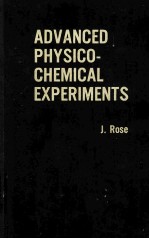图书介绍
ADVANCED PHYSICO-CHEMICAL EXPERINENTSPDF|Epub|txt|kindle电子书版本网盘下载

- 著
- 出版社: SIR ISAAC PITMAN & SONS LTD
- ISBN:
- 出版时间:1964
- 标注页数:414页
- 文件大小:33MB
- 文件页数:226页
- 主题词:
PDF下载
下载说明
ADVANCED PHYSICO-CHEMICAL EXPERINENTSPDF格式电子书版下载
下载的文件为RAR压缩包。需要使用解压软件进行解压得到PDF格式图书。建议使用BT下载工具Free Download Manager进行下载,简称FDM(免费,没有广告,支持多平台)。本站资源全部打包为BT种子。所以需要使用专业的BT下载软件进行下载。如BitComet qBittorrent uTorrent等BT下载工具。迅雷目前由于本站不是热门资源。不推荐使用!后期资源热门了。安装了迅雷也可以迅雷进行下载!
(文件页数 要大于 标注页数,上中下等多册电子书除外)
注意:本站所有压缩包均有解压码: 点击下载压缩包解压工具
图书目录
Ⅰ.ANALYSIS1
1.The Beer-Lambert Law(including Vierordt’smethod)3
2.Chronopotentiometric analysis6
3.“Dead-stop”end-point titrations(amperometric)13
4.Differential conductimetric titration of very weak bases in aqueous solution17
5.Differential potentiometric titrations of mixtures of acids21
6.Estimation of isomers by infra-red absorption25
7.Lewis acids and bases29
8.Morton’s spectrophotometric method32
9.Potentiometric differentiation of alkali metals in mixed solvents36
10.Qualitative analysis of metals by emissionspectroscopy39
11.Quantitative spectrochemical trace analysis by the copper-spark method41
Ⅱ.COMPLEX FORMATION45
12.Chelating ligands in analysis47
13.Chelation and pH51
14.Composition of co-ordination compounds by the method of continuous variation54
15.Hagenmuller’s modification of the method of continuous variation59
16.Composition and stability constant of the uranyl-5-sulphosalicylate complex by the limiting logarithmic method67
17.Polarographic determination of stability con-stants of complex compounds71
18.Stability constants of co-ordination compounds by Bjerrum’s(potentiometric) method76
19.Stability constants of co-ordination compounds(Turner-Anderson method)81
20.Thermodynamics of chelation(effect of metalions)84
Ⅲ.ELECTROCHEMISTRY89
21.Activity coefficient of HC1 in aqueous solution91
22.Activity coefficients and solubilities of sparinglysoluble electrolytes95
23.Analytical boundary method for transportnumbers98
24.The Bronsted theory of acids (strengths of inorganic acids in glacial acetic acid)103
25.Conductimetric titration of mixtures109
26.The Debye-Hǖckel theory and weak electrolytes112
27.Ion-association:Bjerrum’s theory(ion-pair and triple-ion formation)115
28.Ionic product for water(Kw)by the e.m.f.method121
29.The Onsager equation and its modifications124
30.Potentiometry at constant intensity128
31.Thermodynamic ionization constants of weakelectrolytes133
32.Thermodynamic transfer quantities by e.m.f.measurements136
33.“Zwitterions”140
Ⅳ.KINETICS147
34.Catalytic decomposition of hydrogen peroxide149
35.Conductimetric study of the kinetics of hydrolysis of tertiary butyl iodide153
36.Decomposition of ammonia on a tungstensurface158
37.Dilatometric study of reaction kinetics162
38.Energies and entropies of activation of isomericrearrangements166
39.Isomerization equilibrium and kinetics in aqueous solution172
40.Method of ratio variation176
41.Primary salt effect179
42.Secondary salt effect185
43.Spectroscopic study of the alcoholysis of cinnamal chloride190
44.Stirred-flow reactor193
Ⅴ.PHOTOCHRMISTRY197
45.Photobromination of cinnamic acid(chainreaction)199
46.Photocatalysis:the photolysis of uranyl oxalate(uranyl-oxalate aotinometer)203
47.Photochemical dimerization of anthraoene(photo-stationary state)207
48.Photohydrolysis of monochloroacetic acid(quan-tum efficiency)213
49.Photosensitization of chemical reactions(the Eder reaction)218
50.The oxidation of ferrous iron by iodine under the action of ultra-violet radiation221
Ⅵ.SPECTROSCOPY225
51.Deviations from the Beer-Lambert Law227
52.Indicator constants by spectrophotometry233
53.Infra-red spectra and chemical properties of molecules236
54.Ion-association by spectrophotometry240
55.Isobiestic point245
56.Moment of inertia, internuclear distance, and bond strength of HI by infra-red spectra250
57.Quenching of fluorescence257
58.Spectrophotometric determination of molecularweights264
59.Spectroscopic determination of equilibrium con-stants of molecular compounds (charge-transfer spectra)267
60.Spectroscopic study of the dimerization of ethanol in non-polar solvents270
Ⅶ. THERMODYNAMICS275
61.Activities of electrolytic solutes by the freezing-point method277
62.Activities from vapour-pressure data281
63.Activity of thallium in amalgams at 25℃286
64.Partial molal volumes291
65.Partial molal volumes in regular solutions296
66.Solubility of naphthalene in various solvents(ideal and non-ideal solutions)299
67.Thermal dissociation of ferric bromide304
68.Thermodynamic functions of the reaction be-tween malonic acid and some lanthanons308
69.Thermodynamics of vaporization of liquids314
Ⅷ.VARIOUS319
70.Azeotropie distillation(determination of water content)321
71.Dipole moment of 1:8-dichloronaphthalene by Guggenheim’s method326
72.Donnan equilibria329
73.Enthalpy titrations334
74.The Hammett indicator acidity function H340
75.Liquid-liquid adsorption of soluble fatty acids(Gibbs’ and Szyszkowski’s equations)347
76.Magnetic susceptibility (by the Gouy method)353
77.Molecular weight determination by “isothermic distillation” (Barger’s opposed twin capillary method)357
78.The reciprocal salt effect and the Janecke projec-tion (phase rule study)361
79.The ternary diagram by the wet-residue method(phase rule study)368
80.The ternary diagram by the synthetic-complex method (phase rule study)372
81.Thermal decomposition of solids (Prout-Tomp-kins’equation)375
82.The determination of surface areas of adsorbents by means of the B.E.T.isotherm (physicaladsorption)380
Appendix:Erros,mistakes,and deviations.Method of least squares389
Index399